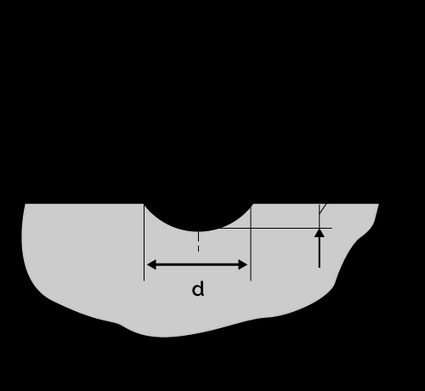Brinell Hardness Number Calculator
The Brinell hardness number calculator will return the BHN or Brinell hardness number, which helps estimate the indentation hardness for a material sample. It is not to be confused with water hardness. This hardness number is estimated after performing an indentation experiment or a test known as the Brinell hardness test.
Swedish engineer Johan August Brinell proposed this procedure for indentation hardness in the year 1900. Since then, the Brinell hardness test has become a standardized test in metallurgy and material science to estimate the hardness more so because of its non-destructive nature.
The basic idea behind this test is the calculation of pressure based on the force applied and the indentation area. Read on to understand the Brinell hardness scale and conduct the Brinell hardness test.
Brinell hardness test — What is Brinell hardness number?
The Brinell hardness test is a non-destructive test performed by using a small ball-shaped indentor that is pressed onto the material specimen with a standard load value. The depth and the diameter of the indentor are then recorded, and you use them to calculate the Brinell hardness number.

The indentor is a ball made of steel or tungsten carbide having a diameter, D. Consider the ball indentor pressed at a load or force value of P newtons. The equation gives the Brinell hardness number:
where:
P– Test force (in Newtons); andd– Diameter of indentation (in mm).
You can find the details of the Brinell hardness test in the international standards ISO 6506-1 for metallic testing.
How to calculate Brinell hardness number
To calculate Brinell hardness number:
- Enter the load applied,
P. - Insert the diameter of the indentor,
D. - Fill in the diameter of indentation,
d. - The calculator will determine the surface area,
A, and the Brinell hardness number (HBW).
Example: Using the brinell hardness number calculator
Determine the Brinell hardness number for a material specimen having an indentation diameter of 3 mm. The test is conducted using an indentor with a 10 mm diameter and a test force of 294.2 N.
To calculate Brinell hardness number:
- Enter the load applied,
P = 294.2 N. - Insert the diameter of the indentor,
D = 10 mm. - Fill in the diameter of indentation,
d = 3 mm. - The Brinell hardness number (HBW) is then calculated:
Brinell hardness chart
You can represent the Brinell hardness for a material specimen as per the ISO 6506-1. For example:
- 600 HBW 1 / 30 / 20
where:
- 600 – Brinell hardness value;
- HBW – Hardness symbol;
- 1 – Ball diameter in mm;
- 30 – Applied test force (in kgf); and
- 20 – Duration time of the test force.
The following table contains the Brinell hardness numbers for some materials.
Material | Hardness |
|---|---|
Copper | 35 HB |
Aluminum (pure) | 15 HB |
AW-6060 aluminum | 75 HB |
Glass | 1550 HB |
Rhenium diboride | 4600 HB |
Applications and similar tests
The Brinell hardness scale is often connected with the ultimate tensile strength (UTS) of materials or alloys, but it is not applicable for all ranges of Brinell hardness number. You can also lookup Meyer's index or law, which is an empirical relation for converting the Brinell hardness number to ultimate tensile strength (UTS). Still, it is limited to a series of indentor diameters.
Some of the applications of this test include testing hardness for rocks, inspecting welded joints (see welding calculator), characterization of surface coatings and thin films, and material behavior. Researchers and engineers also use it to develop material modeling frameworks for crystalline materials. Some variations of this test are broadly categorized as micro or nano indentations; they are primarily used but not limited to thin surface layers like films and coatings.
Some other indentation tests similar to the Brinell hardness test are Vickers hardness (cf. vickers hardness number calculator) and Rockwell hardness (see rockwell hardness conversion calculator), which are applicable for a wide range of categories of metals and alloys. In addition to this, some material-specific tests also exist, such as the Janka hardness test for wood, Knoop hardness test for ceramics, or Shore and Barcol hardness tests for polymers and composites, respectively.
FAQs
What is brinell hardness test?
The Brinell hardness test is a non-destructive indentation test that is used to measure the hardness of a material. It is performed using a small indentor that is impressed upon the material surface, after which the diameter of indentation is measured to estimate the Brinell hardness number.
How do I perform the Brinell hardness test?
As per the testing standard ISO 6506-1:
- Begin the test by bringing the indentor in contact with the test surface.
- Apply the force perpendicular to the test surface, but without any shock, or vibration, until the applied force is attained as per the test standard.
- Maintain the test force for 14 seconds. It could be longer for specific materials.
- Remove the load and measure the diameter of indentation in two perpendicular directions.
- Use the formula to obtain the Brinell hardness number.
What is the Brinell hardness number for copper?
The Brinell hardness number for mild steel is 35 HB. This value implies that during the Brinell hardness test, the user will observe an indentation of diameter about 1.35 mm when a load of 500 N is applied on the material specimen using an indentor of diameter having 10 mm.
What is the Brinell hardness number for aluminum?
The Brinell hardness number for aluminum is 15 HB. This value implies that during the Brinell hardness test, the user will observe an indentation of diameter about 2.05 mm when a load of 500 N is applied on the material specimen using an indentor of diameter having 10 mm.